The Aspiration Control Systems Market is estimated to be valued at USD 392.4 million in 2025 and is projected to reach USD 736.5 million by 2035, registering a compound annual growth rate (CAGR) of 6.5% over the forecast period.
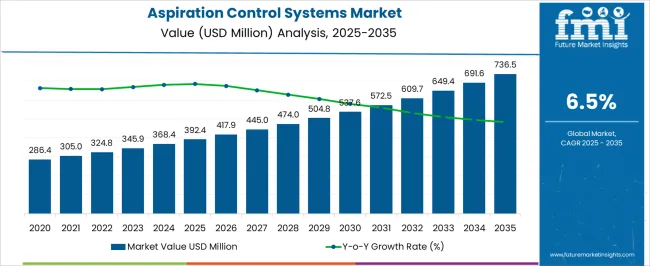
| Metric | Value |
|---|---|
| Aspiration Control Systems Market Estimated Value in (2025 E) | USD 392.4 million |
| Aspiration Control Systems Market Forecast Value in (2035 F) | USD 736.5 million |
| Forecast CAGR (2025 to 2035) | 6.5% |
The aspiration control systems market is experiencing steady growth, driven by rising demand for advanced medical devices that enhance safety and efficiency in surgical and diagnostic procedures. These systems are gaining importance due to their role in managing fluids, maintaining sterile conditions, and improving precision during critical interventions. Growth is being supported by increasing surgical volumes globally, the rising prevalence of chronic diseases, and heightened investments in healthcare infrastructure.
Technological advancements, particularly in integrated aspiration mechanisms and digital control features, are enhancing product efficiency and reducing procedural risks. The market is also being influenced by stricter healthcare regulations that emphasize infection prevention and procedural safety, further supporting the adoption of sophisticated aspiration systems.
Hospitals and healthcare providers are focusing on solutions that provide consistent performance, reduce the risk of contamination, and improve patient outcomes As the demand for minimally invasive surgeries rises and medical facilities continue to upgrade equipment, the aspiration control systems market is expected to demonstrate strong and sustained growth across both developed and emerging regions.
The aspiration control systems market is segmented by product, application, end-user, and geographic regions. By product, aspiration control systems market is divided into Mechanical Aspiration System with Integrated Control and Basic Aspiration System. In terms of application, aspiration control systems market is classified into Body Fluids Removal, Bone Fragments Removal, and Others. Based on end-user, aspiration control systems market is segmented into Hospital, Specialized Clinics, Diagnostic Laboratories, Private Diagnostic Laboratories, Public Diagnostic Laboratories, and Educational and Research Institutes. Regionally, the aspiration control systems industry is classified into North America, Latin America, Western Europe, Eastern Europe, Balkan & Baltic Countries, Russia & Belarus, Central Asia, East Asia, South Asia & Pacific, and the Middle East & Africa.
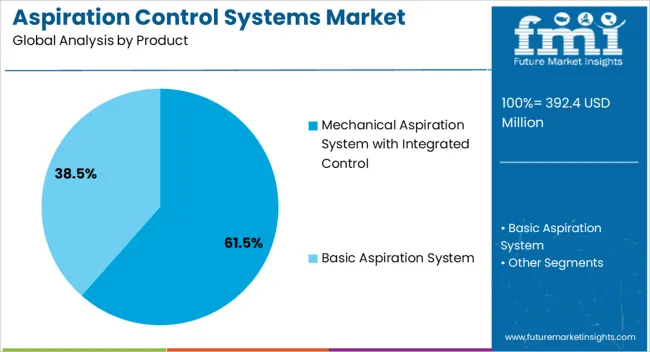
The mechanical aspiration system with integrated control segment is projected to account for 61.5% of the aspiration control systems market revenue share in 2025, making it the leading product type. Its dominance is being driven by the reliability, precision, and ease of use it offers in surgical environments. Integrated control mechanisms enhance the ability of clinicians to manage suction levels effectively, minimizing complications during delicate procedures.
The efficiency of these systems in maintaining continuous fluid removal without interruptions has established their importance in operating rooms. Their widespread use is also being supported by cost-effectiveness and adaptability across multiple medical disciplines. Manufacturers are focusing on developing integrated models with enhanced ergonomic features and automation capabilities to improve clinical workflow.
The preference for mechanical aspiration systems with integrated control is further reinforced by their proven track record in ensuring consistent performance and patient safety As healthcare providers prioritize advanced devices that combine operational reliability with regulatory compliance, this segment is expected to maintain its leadership position within the market.
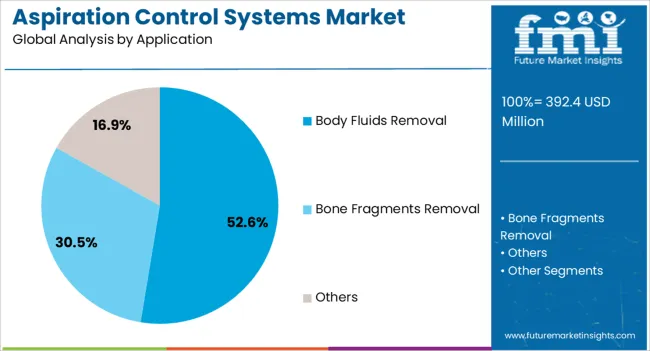
The body fluids removal application segment is anticipated to represent 52.6% of the aspiration control systems market revenue share in 2025, establishing itself as the leading application area. Its growth is being supported by the rising incidence of surgical procedures, trauma cases, and conditions requiring effective fluid management. The use of aspiration control systems for body fluids removal significantly improves visibility during surgery, reduces infection risks, and enhances the overall safety of procedures.
Hospitals are increasingly relying on advanced systems to manage large volumes of fluids efficiently, particularly in complex or prolonged operations. The segment is further benefitting from technological enhancements that allow for precise control and automated regulation of fluid suction, thereby minimizing manual intervention.
Regulatory emphasis on improving patient outcomes and reducing complications during surgeries is also influencing adoption As surgical volumes continue to grow globally, coupled with the need for safer and more efficient fluid management, body fluids removal applications are expected to remain the dominant area of utilization in the market.
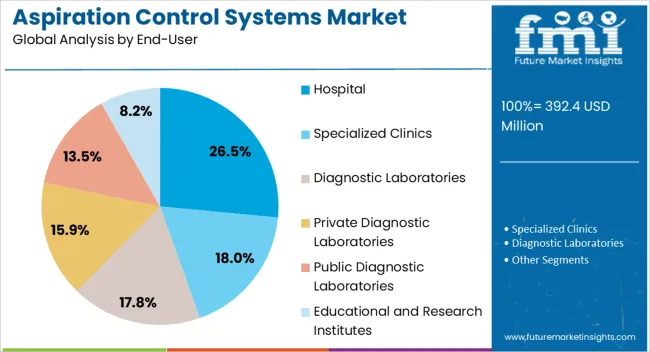
The hospital segment is projected to capture 26.5% of the aspiration control systems market revenue share in 2025, making it the leading end-user category. Its prominence is being reinforced by the extensive demand for aspiration systems across surgical theaters, intensive care units, and emergency departments. Hospitals are the primary centers for high-volume surgical procedures, which require reliable aspiration systems to ensure safety and efficiency.
Investments in advanced medical infrastructure and the continuous upgrading of surgical equipment are supporting strong adoption within this segment. Hospitals prioritize solutions that provide consistent suction performance, meet stringent regulatory requirements, and offer adaptability for multiple clinical applications.
The need for integrated systems that improve workflow efficiency, reduce infection risks, and support minimally invasive procedures has further increased reliance on advanced aspiration control devices With healthcare spending rising globally and hospitals focusing on upgrading medical technologies, this end-user segment is expected to continue leading the market, benefitting from both technological advancements and the growing demand for complex surgical care.
The primary market trend for aspiration control systems has been an increase in research and development investment. To take advantage of the enormous untapped market prospects in the developing world, the industry's top companies are concentrating on creating goods that are both affordable and of excellent quality. The rising expenditure on research and development as well as the rising number of new product approvals are evidence of this.
Healthcare facilities preferred aspiration control devices for treating ischemic stroke, which typically affects elderly persons. Individuals older than 40 have been found to have an increased risk of stroke as a result of modern lifestyle, stress, and eating choices. As a result, aspiration control systems manufacturers are anticipated to witness an increase in sales from these sectors. Furthermore, stroke attack leaves over 65% of patients in need of physical support or help, making it the main cause of disability among elderly people.
The WHO estimates that 15 million people worldwide are expected to suffer a stroke each year. The aspiration control system is the most favored therapy by large healthcare organizations for acute ischemic stroke because it enhances functional results and reduces patient mortality. These factors are propelling the market growth during the projection period.
Since hospitals have better medical facilities and access to cutting-edge equipment than emergency clinics, hospitals are often favored by patients. The sector is expanding due to the patient's propensity to go to the hospital since they receive treatment within eight hours of the beginning of symptoms.
The prevalence of acute ischemia illnesses is projected to rise, and consumer awareness of aspiration control systems is also expected to rise. In the United States and Europe, stroke is the leading cause of death and disability. The primary method of treating an acute ischemic stroke is reperfusion therapy utilizing aspiration control systems. Since acute ischemia illness must be treated within eight hours of the beginning of symptoms, hospitals are still the ideal location for treatment, propelling market growth.
Aspiration control system market is gaining high traction owing to sophisticated surgeries being carried out worldwide that require high degree of precision. Also, aspiration control system is gaining wide acceptance among various biotechnological centers and diagnostic centers where there is a need for safe and efficient collection and disposal of biological liquid waste for research purpose.
Aspiration control system market is mainly driven by increasing per capita healthcare expenditure, increase in R&D spending in various research and educational institutes, and substantial rise in various sophisticated surgeries such as bone marrow transplants and ophthalmic vitrectomy surgery.
Furthermore, changing economic scenarios such as increasing FDI influx in healthcare sector in developing regions is expected to boost overall sales of these devices in these regions.
Though this market is expected to witness substantial growth over the forecast period, high cost of aspiration control system devices, lack of skilled professionals for this sensitive surgical procedure, along with conventional alternative surgical devices could hamper the overall revenue growth of this market.
On the basis of geography, the global aspiration control systems market is segmented into five key regions: North America, Latin America, Europe, Asia Pacific and Middle East & Africa. North America contributes maximum share to the global aspiration control system market.
European countries are expected to represent significant growth rates owing to high awareness and increased spending on R&D. Furthermore, there is high adoption rate of technically advanced equipment in North America and Europe, which in turn creates significant demand for aspiration control systems. In the Asia Pacific, China, Japan and India are promising markets for aspiration control systems.
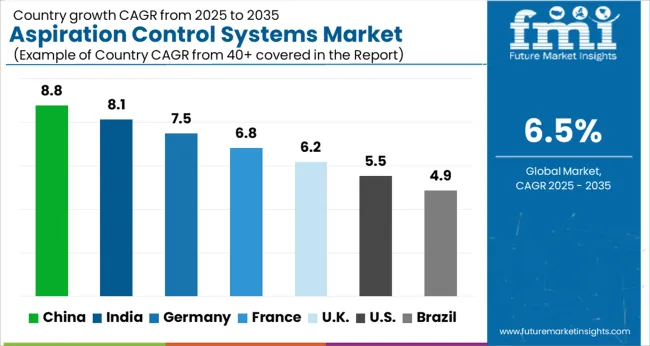
| Country | CAGR |
|---|---|
| China | 8.8% |
| India | 8.1% |
| Germany | 7.5% |
| France | 6.8% |
| UK | 6.2% |
| USA | 5.5% |
| Brazil | 4.9% |
The Aspiration Control Systems Market is expected to register a CAGR of 6.5% during the forecast period, exhibiting varied country level momentum. China leads with the highest CAGR of 8.8%, followed by India at 8.1%. Developed markets such as Germany, France, and the UK continue to expand steadily, while the USA is likely to grow at consistent rates. Brazil posts the lowest CAGR at 4.9%, yet still underscores a broadly positive trajectory for the global Aspiration Control Systems Market. In 2024, Germany held a dominant revenue in the Western Europe market and is expected to grow with a CAGR of 7.5%. The USA Aspiration Control Systems Market is estimated to be valued at USD 145.3 million in 2025 and is anticipated to reach a valuation of USD 248.8 million by 2035. Sales are projected to rise at a CAGR of 5.5% over the forecast period between 2025 and 2035. While Japan and South Korea markets are estimated to be valued at USD 20.1 million and USD 10.6 million respectively in 2025.
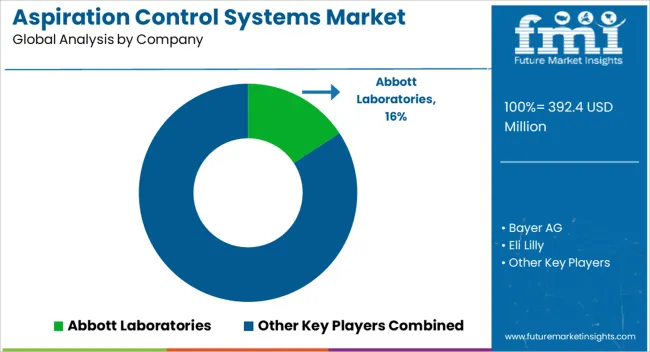
| Item | Value |
|---|---|
| Quantitative Units | USD 392.4 Million |
| Product | Mechanical Aspiration System with Integrated Control and Basic Aspiration System |
| Application | Body Fluids Removal, Bone Fragments Removal, and Others |
| End-User | Hospital, Specialized Clinics, Diagnostic Laboratories, Private Diagnostic Laboratories, Public Diagnostic Laboratories, and Educational and Research Institutes |
| Regions Covered | North America, Europe, Asia-Pacific, Latin America, Middle East & Africa |
| Country Covered | United States, Canada, Germany, France, United Kingdom, China, Japan, India, Brazil, South Africa |
| Key Companies Profiled | Abbott Laboratories, Bayer AG, Eli Lilly, Merck Serono, Actavis, Sanofi S.A, VACUUBRAND GMBH, INTEGRA Biosciences AG, Gilson Inc, and Hettich Benelux B.V |
The global aspiration control systems market is estimated to be valued at USD 392.4 million in 2025.
The market size for the aspiration control systems market is projected to reach USD 736.5 million by 2035.
The aspiration control systems market is expected to grow at a 6.5% CAGR between 2025 and 2035.
The key product types in aspiration control systems market are mechanical aspiration system with integrated control and basic aspiration system.
In terms of application, body fluids removal segment to command 52.6% share in the aspiration control systems market in 2025.






Our Research Products

The "Full Research Suite" delivers actionable market intel, deep dives on markets or technologies, so clients act faster, cut risk, and unlock growth.

The Leaderboard benchmarks and ranks top vendors, classifying them as Established Leaders, Leading Challengers, or Disruptors & Challengers.

Locates where complements amplify value and substitutes erode it, forecasting net impact by horizon

We deliver granular, decision-grade intel: market sizing, 5-year forecasts, pricing, adoption, usage, revenue, and operational KPIs—plus competitor tracking, regulation, and value chains—across 60 countries broadly.

Spot the shifts before they hit your P&L. We track inflection points, adoption curves, pricing moves, and ecosystem plays to show where demand is heading, why it is changing, and what to do next across high-growth markets and disruptive tech

Real-time reads of user behavior. We track shifting priorities, perceptions of today’s and next-gen services, and provider experience, then pace how fast tech moves from trial to adoption, blending buyer, consumer, and channel inputs with social signals (#WhySwitch, #UX).

Partner with our analyst team to build a custom report designed around your business priorities. From analysing market trends to assessing competitors or crafting bespoke datasets, we tailor insights to your needs.
Supplier Intelligence
Discovery & Profiling
Capacity & Footprint
Performance & Risk
Compliance & Governance
Commercial Readiness
Who Supplies Whom
Scorecards & Shortlists
Playbooks & Docs
Category Intelligence
Definition & Scope
Demand & Use Cases
Cost Drivers
Market Structure
Supply Chain Map
Trade & Policy
Operating Norms
Deliverables
Buyer Intelligence
Account Basics
Spend & Scope
Procurement Model
Vendor Requirements
Terms & Policies
Entry Strategy
Pain Points & Triggers
Outputs
Pricing Analysis
Benchmarks
Trends
Should-Cost
Indexation
Landed Cost
Commercial Terms
Deliverables
Brand Analysis
Positioning & Value Prop
Share & Presence
Customer Evidence
Go-to-Market
Digital & Reputation
Compliance & Trust
KPIs & Gaps
Outputs
Full Research Suite comprises of:
Market outlook & trends analysis
Interviews & case studies
Strategic recommendations
Vendor profiles & capabilities analysis
5-year forecasts
8 regions and 60+ country-level data splits
Market segment data splits
12 months of continuous data updates
DELIVERED AS:
PDF EXCEL ONLINE
Door Controller Systems Market
Version Control Systems Market Size and Share Forecast Outlook 2025 to 2035
Driveline Control Systems and Devices Market Size and Share Forecast Outlook 2025 to 2035
Vibration Control Systems Market Growth - Trends & Forecast 2025 to 2035
Valve Remote Control Systems Market Analysis by Type, Application and Region - Forecast for 2025 to 2035
Train Control and Management Systems Market Size and Share Forecast Outlook 2025 to 2035
EV Telematics Control Systems Market Size and Share Forecast Outlook 2025 to 2035
Competitive Overview of Air Pollution Control Systems Providers
Air Pollution Control Systems Market – Applications & Growth Forecast 2025-2035
Ischemic Stroke Aspiration Systems Market - Trends & Forecast 2025 to 2035
Combustion Controls, Equipment & Systems Market – Forecast 2025 to 2035
Electronic Control Unit in Automotive Systems Market Size and Share Forecast Outlook 2025 to 2035
Demand for Vibration Control Systems in Japan Size and Share Forecast Outlook 2025 to 2035
Demand for Vibration Control Systems in USA Size and Share Forecast Outlook 2025 to 2035
Automotive Touch Screen Control Systems Market Growth - Trends & Forecast 2025 to 2035
Card-Based Electronic Access Control Systems Market Growth - Forecast 2025 to 2035
Control Network Modules Market Size and Share Forecast Outlook 2025 to 2035
Controllable Shunt Reactor for UHV Market Size and Share Forecast Outlook 2025 to 2035
Control Room Solution Market Size and Share Forecast Outlook 2025 to 2035
Control Knobs for Panel Potentiometer Market Size and Share Forecast Outlook 2025 to 2035

Thank you!
You will receive an email from our Business Development Manager. Please be sure to check your SPAM/JUNK folder too.
Chat With
MaRIA